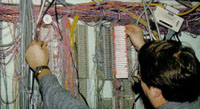Existing Copper Saves Millions
By using existing copper wire instead of installing optical fiber cables, Wayne State University will save millions. The need arose to greatly speed up data transmission between dozens of sites in the campus, which is pieced over three square miles of downtown Detroit. In addition, 30 libraries in metro Detroit needed faster access to the card-catalog databank supported on one of the University's three mainframes.
Boosting Copper Capacity
An optical fiber network was one solution, according to Brian Holmes, the university's network engineer. That would have cost about $4 million including the required electronics; also, it would have taken a lot of time to install. Instead, Holmes specified "black boxes" that immediately upgrade standard, copper-wire telephone lines to high speed digital links, known in the telecommunications industry as high-density subscriber loops (HDSL).

The boxes, "Campus-E1" units from PairGain Technologies, Inc., Cerritos, California, cost about $2,000 apiece. A pair is required per circuit, one at the user end and the other tied to one of the university's three mainframes. They support data transmission at two million bits per second. That's 32 times faster than the previous 56-kbps "Data Path" service provided by the local phone company.
Installation
 Matt Lessins, systems analyst, traces a copper twisted pair, the primary conductors for high volume data transmission among Wayne State Univeristy facilities and public libraries in metro Detroit. USing existing copper wiring enhanced by HDSL does the job for a fraction of the cost of a fiber optics alternative.
Matt Lessins, systems analyst, traces a copper twisted pair, the primary conductors for high volume data transmission among Wayne State Univeristy facilities and public libraries in metro Detroit. USing existing copper wiring enhanced by HDSL does the job for a fraction of the cost of a fiber optics alternative."Installation of the PairGain units was a snap," according to Holmes, who did it himself. Another requirement was simple reconnection of the switched circuits into dedicated lines by the phone company. This raised the monthly charge per circuit from $36 to $50. Voice service was not provided over the lines either before or after reconfiguration.
Matt Lessins, system analyst, (above) traces a copper twisted pair, the primary conductors for high volume data transmission among Wayne State University facilities and public libraries in metro Detroit. Using existing copper wiring enhanced by HDSL does the job for a fraction of the cost of a fiber optics alternative.
To complete the installation, two routers (costing $1,500 apiece) are required per HDSL circuit. However, the routers - from Advanced Computer Communications, Santa Barbara, California - would also have been needed with the fiber optics alternative, Holmes noted.
An Investment for the Future - Savings for Today
So far, Holmes has upgraded seven circuits to HDSL. In time, he expects to upgrade another 15 to 20, including several to local public libraries (those within two miles, the upper limit for PairGain equipment on the existing twisted-pair copper cables). This works out to a total investment cost for HDSL of about $240,000, plus a $14 per circuit increase in monthly tariff charges. That's a great bargain compared to $4 million for the fiber optics alternative. It's no wonder the University's management is "very happy," said Holmes.
There was one other alternative that Holmes rejected, "T-1" service, with the local phone company installing, maintaining and retaining ownership of the equipment. While this would have allowed the University to avoid an initial investment, it would result in much higher monthly charges of $250 per circuit. Besides PairGain, HDSL equipment is available from Adtran, Inc., Huntsville, Alabama, and Tellabs Operations, Inc., Lisle, Illinois.
Adtran: 205/971-8000.
PairGain (Cerritos, California): 800/638-0031.
Tellabs: 708/512-7501.
Also in this Issue:
- Boosting Capacity of Copper
- Copper, Brass and Bronze Go Underground
- Existing Copper Saves Millions
- Copper says "Welcome" at Finnish Chancery
- Fume-free Copper Chosen Over Plastics
- Copper Helps Protect Precious PCs
